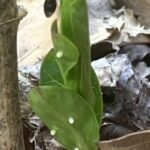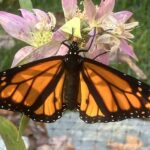An Icon on the Edge
On February 7, Xerces Ambassador and Wild Ones Chesapeake Bay President Marlene Smith gave a presentation on “Eastern Monarchs 101” to the North Four Corners Civic Association in Silver Spring, Maryland. Little did she know as she was giving her talk that the latest news on the eastern monarch population that overwinters in Mexico was being released, and the news was not good.

According to the World Wildlife Fund, “New data detailing the abundance of the eastern monarch butterfly colonies wintering in central Mexico’s forests estimate that the species occupied only 2.2 acres during the 2023-2024 winter season—59% less than the previous year when scientists observed 5.5 acres. The annual survey is undertaken by WWF and its partners, … and is considered a benchmark for the overall abundance of the species. Experts measure the area of forest in which monarch butterflies hibernate each winter, providing a scientific indicator of their population status.”
“Scientists believe that climatic variations in the monarch’s breeding areas in Canada and the United States gave rise to high temperatures and drought, which reduced the abundance of milkweed, the only plant in which the butterflies lay their eggs. Land-use changes in the United States, combined with the widespread use of herbicides, also contributed to the loss of milkweed and other nectar plants essential to feeding adult monarchs.” Read more from the WWF.
“With the eastern monarch butterfly population overwintering in Mexico reaching its second smallest size on record, the need for action is clear: we must rewild our gardens, parks, and communities. As the monarchs are making headlines, more attention than ever is being paid to the native plant movement,” according to Wild Ones.

In addition to the vial need to conserve monarch overwintering sites, Xerces offers these five actions you can take to secure a more hopeful future for monarchs:
- Plant native milkweed and nectar plants. Connect with your local Wild Ones chapter to learn which milkweed species grows well in your area and find out which species monarchs favor.
- Get involved locally. Join and support Wild Ones! At the local level, Wild Ones chapters offer a knowledgeable, hands-on, and supportive community. Take Xerces Pollinator Protection Pledge to commit to working every day to protect pollinators and their habitats.
- Avoid pesticides. Invertebrates are vitally important to a healthy environment, including controlling pests, pollinating flowering plants, and providing food for other wildlife. Reduce or avoid herbicide and insecticide use, especially systemic insecticides.
- Spread awareness. Share your knowledge and passion for monarch conservation with friends and family. Education is a powerful tool for change. Keep an eye out for newly developed monarch-related content coming to the Wild Ones members site this summer.
- Contribute to community science. Read more about community science programs you can make an impact in here: Community Science – Wild Ones: Native Plants, Natural Landscapes
For more information, check out the following articles from Xerces:
Eastern Monarch Butterfly Overwintering Area in Mexico Drops Precipitously






